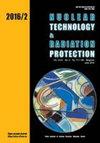Possibility of application nuclear magnetic resonance to measure fluid flow
IF 0.9
4区 工程技术
Q3 NUCLEAR SCIENCE & TECHNOLOGY
引用次数: 1
Abstract
The paper considers the application of nuclear magnetic resonance to measure fluid flow. The paper is of an experimental nature. Flowmeter based on nuclear magnetic resonance is extremely precise. The combined measurement uncertainty can be 0.1 %. Such a value of measurement uncertainty indicates that it is a matter of a deterministic and not of a stochastic quantity. This high degree of reliability of the method is theoretically and mathematically described. The paper presents a measurement scheme for flow measurement. Water flow measurement was performed on the principle of nuclear magnetic resonance and on the basis of tritiated water (which is considered to be the most accurate classical method). The obtained results show that the measurement of flow based on nuclear magnetic resonance is more accurate (especially at higher flow). This is explained by the higher inertial mass of HTO tritiated water molecules than the standard H2O water mass and the possible transition of tritiated water to H3HeO. In this way, it has been proven that tracing water based on nuclear magnetic resonance is the only real tracing of water by water. The obtained results shows that tracing water with tritiated or heavy water is not tracing water by water which is explained by different inertial masses.应用核磁共振测量流体流动的可能性
研究了核磁共振在流体流动测量中的应用。这篇论文是实验性的。基于核磁共振的流量计精度极高。组合测量不确定度可达0.1%。这样的测量不确定度值表明它是一个确定性的量,而不是一个随机的量。从理论上和数学上描述了这种方法的高可靠性。本文提出了一种流量测量方案。水流测量采用核磁共振原理,以氚化水为基础(被认为是最精确的经典方法)。结果表明,基于核磁共振的流量测量精度更高(特别是在大流量时)。这可以解释为HTO氚化水分子的惯性质量高于标准H2O水的质量,以及氚化水可能向H3HeO转变。这样就证明了基于核磁共振的示踪水是唯一真正的水对水的示踪。所得结果表明,用氚化水或重水示踪水不是用水示踪水,这可以用不同的惯性质量来解释。
本文章由计算机程序翻译,如有差异,请以英文原文为准。
求助全文
约1分钟内获得全文
求助全文
来源期刊

Nuclear Technology & Radiation Protection
NUCLEAR SCIENCE & TECHNOLOGY-
CiteScore
2.00
自引率
41.70%
发文量
10
审稿时长
6-12 weeks
期刊介绍:
Nuclear Technology & Radiation Protection is an international scientific journal covering the wide range of disciplines involved in nuclear science and technology as well as in the field of radiation protection. The journal is open for scientific papers, short papers, review articles, and technical papers dealing with nuclear power, research reactors, accelerators, nuclear materials, waste management, radiation measurements, and environmental problems. However, basic reactor physics and design, particle and radiation transport theory, and development of numerical methods and codes will also be important aspects of the editorial policy.
 求助内容:
求助内容: 应助结果提醒方式:
应助结果提醒方式:


